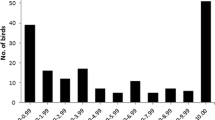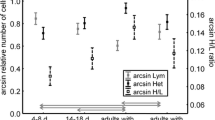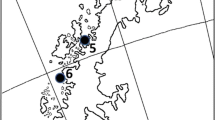Abstract
Haematological methods are widely utilised among avian ecologists as a means for individual health assessment. However, the technical simplicity of some of the tests may easily lead to oversimplification of the evaluation. Here, we show in the Scarlet Rosefinch (Carpodacus erythrinus) that haematological parameters other than the widely used heterophil/lymphocyte (H/L) ratio may be important to investigate. We give the full description of seven basic haematological traits (leukocyte differential count, immature erythrocyte count, haematocrit, mean cell volume, total red and white blood cell count and blood parasite occurrence). Most remarkably, the examination of 178 adults and 155 nestlings has revealed that this species has an extraordinarily high proportion of basophils among the peripheral blood leukocytes (on average about 42 and 56%, respectively). Although the high basophil count is a general trait even in healthy individuals of this species, the proportion of these cells is condition-dependent and is further increased by Haemoproteus infection. Our results also suggest that the immature erythrocyte count in the peripheral blood is a good predictor of the nestlings’ growth rate. We conclude that the Rosefinch haematology differs strikingly from other avian species with known values of basic haematological parameters. We therefore emphasise the importance of a general haematological examination, based on material obtained by an appropriate method (e.g. for smear preparation, we recommend using differential staining and avoiding prior methanol fixation).



Similar content being viewed by others
References
Albrecht T (2004) Edge effect in wetland-arable land boundary determines nesting success of scarlet rosefinches (Carpodacus erythrinus) in the Czech Republic. Auk 121:361–371
Albrecht T, Schnitzer J, Kreisinger J, Exnerova A, Bryja J et al (2007) Extra pair paternity and the opportunity for sexual selection in long-distant migratory passerines. Behav Ecol 18:477–486
Altan O, Pabuccuoglu A, Altan A, Konyalioglu S, Bayraktar H (2003) Effect of heat stress on oxidative stress, lipid peroxidation and some stress parameters in broilers. Br Poult Sci 44:545–550
Ardia DR, Schat KA (2008) Ecoimmunology. In: Davison F, Kaspers B, Schat KA (eds) Avian immunology. Academic/Elsevier, London, pp 421–441
Bedáňová I, Voslářová E, Večerek V, Pištěková V, Chloupek P (2007) Haematological profile of broiler chickens under acute stress due to shackling. Acta Vet BRNO 76:129–135
Belskii EA, Lugas’kova NV, Karfidova AA (2005) Reproductive parameters of adult birds and morphophysiological characteristics of chicks in the pied flycatcher (Ficedula hypoleuca Pall.) in technogenically polluted habitats. Russ J Ecol 36:329–335
Campbell TW, Ellis CK (2007) Avian and exotic animal hematology and cytology, 3rd edn. Blackwell, Ames
Carleton RE (2008) Ectoparasites affect haemoglobin and percentages of immature erythrocytes but not hematocrit in nestling eastern bluebirds. Wilson J Ornithol 120:565–568
Chakarov N, Boerner M, Krüger O (2008) Fitness in common buzzards at the cross-point of opposite melanin-parasite interactions. Funct Ecol 22:1062–1069
Coke RL, West GD, Hoover JP (2004) Hematology and plasma biochemistry of captive puna ibis (Plegadis ridgewayi). J Wildl Dis 40:141–144
Constantino BT, Cogionis B (2000) Nucleated RBCs—significance in the peripheral blood film. Laboratory Medicine 31:223–229
Cramp S, Perrins CM, Brooks DJ (1994) The birds of the western Palearctic. Oxford University Press, Oxford
Crawley MJ (2002) Statistical computing: an introduction to data analysis using s-plus. Wiley, Chichester
Daloia MA, Samour JH, Howlett JC, Bailey TA, Naldo J (1994) Haemopathological responses to chronic inflammation in the houbara-bustard (Chlamydotis-Undulata-Macqueenii). Comp Haematol Int 4:203–206
Davis AK (2005) Effect of handling time and repeated sampling on avian white blood cell counts. J Field Ornithol 76:334–338
Davis AK (2009) The wildlife leukocytes webpage: the ecologist’s source for information about leukocytes of wildlife species. www.wildlifehematology.uga.edu
Davis AK, Cook KC, Altizer S (2004) Leukocyte profiles of house finches with and without mycoplasmal conjunctivitis, a recently emerged bacterial disease. EcoHealth 1:362–373
Davis AK, Maney DL, Maerz JC (2008) The use of leukocyte profiles to measure stress in vertebrates: a review for ecologists. Funct Ecol 22:760–772
Dubiec A, Witek M, Cichon M (2005) Seasonal decline in leukocyte concentrations and reproductive output in female great tits (Parus major). Auk 12:27–34
Dufva R, Allander K (1995) Intraspecific variation in plumage coloration reflects immune-response in great tit (Parus major) males. Funct Ecol 9:785–789
El Lethey H, Huber-Eicher B, Jungi TW (2003) Exploration of stress-induced immunosuppression in chickens reveals both stress-resistant and stress-susceptible antigen responses. Vet Immunol Immunopathol 95:91–101
Ewenson EL, Zann RA, Flannery GR (2001) Body condition and immune response in wild zebra finches: effects of capture, confinement and captive-rearing. Naturwissenschaften 88:391–394
Falcone FH, Pritchard DI, Gibbs BF (2001) Do basophils play a role in immunity against parasites? Trends Parasitol 17:126–129
Fokidis HB, Greiner EC, Deviche P (2008) Interspecific variation in avian blood parasites and haematology associated with urbanization in a desert habitat. J Avian Biol 39:300–310
Friedl TP, Edler R (2005) Stress-dependent trade-off between immunological condition and reproductive performance in the polygynous red bishop (Euplectes orix). Evol Ecol 19:221–239
Fudge AM (1989) Avian hematology: identification and interpretation. Proceedings association of avian veterinarians 284–292
Garvin MC, Homer BL, Greiner EC (2003) Pathogenicity of Haemoproteus danilewskyi, Kruse, 1890, in blue jays (Cyanocitta cristata). J Wildl Dis 39:161–169
Hauptmanová K, Literák I, Bártová E (2002) Haematology and leucocytozoonosis of great tits (Parus major L.) during winter. Acta Vet Brno 71:199–204
Lazarevic M, Zikic D, Uscebrka G (2000) The influence of long term sound stress on the blood leukocyte count, heterophil/lymphocyte ratio and cutaneous basophil hypersensitive reaction to phytohemagglutinin in broiler chickens. Acta Vet Beogr 50:63–75
Lessells CM, Boag PT (1987) Unrepeatable repeatabilities—a common mistake. Auk 104:116–121
Lobato E, Moreno J, Merino S, Sanz JJ, Arriero E (2005) Haematological variables are good predictors of recruitment in nestling pied flycatchers (Ficedula hypoleuca). Ecoscience 12:27–34
Lucas AM, Jamroz C (1961) Atlas of avian hematology. United States Department of Agriculture, Washington
Maxwell MH (1981) Leucocyte diurnal rhythms in normal and pinealectomize juvenile female fowls. Res Vet Sci 31:113–115
Maxwell MH (1993) Avian blood leukocyte responses to stress. Worlds Poult Sci J 49:34–43
Maxwell MH, Robertson GW (1995) The avian basophilic leukocyte: a review. Worlds Poult Sci J 51:307–325
Mercurio DDG, Marte BRG, Cruzana BC (2008) Hematological values of chestnut mannikin (Lonchura malacca) caught in Laguna. Philipp J Vet Med 45:63–66
Moreno J, de Leon A, Fargallo JA, Moreno E (1998) Breeding time, health and immune response in the chinstrap penguin Pygoscelis antarctica. Oecologia 115:312–319
Norte AC, Araujo PM, Sampaio HL, Sousa JP, Ramos JA (2009a) Haematozoa infections in a great tit Parus major population in Central Portugal: relationships with breeding effort and health. Ibis 151:677–688
Norte AC, Ramos JA, Sousa JP, Sheldon BC (2009b) Variation of adult great tit Parus major body condition and blood parameters in relation to sex, age, year and season. J Ornithol 150:651–660
Ots I, Hõrak P (1998) Health impact of blood parasites in breeding great tits. Oecologia 116:441–448
Ots I, Murumagi A, Hõrak P (1998) Haematological health state indices of reproducing great tits: methodology and sources of natural variation. Funct Ecol 12:700–707
Risberg L, Stjernberg T (1997) Scarlet Rosefinch (Carpodacus erythrinus). In: Hagemeijer WJM, Blair MJ (eds) The EBCC atlas of European breeding birds. Poyser, London, pp 732–733
Robertson GW, Maxwell MH (1990) Modified staining techniques for avian blood-cells. Br Poult Sci 31:881–886
Ruiz G, Rosenmann M, Novoa FF, Sabat P (2002) Hematological parameters and stress index in rufous-collared sparrows dwelling in urban environments. Condor 104:162–166
Scope A, Filip T, Gabler C, Resch F (2002) The influence of stress from transport and handling on hematologic and clinical chemistry blood parameters of racing pigeons (Columba livia domestica). Avian Dis 46:224–229
Senar JC, Pascual J (1997) Keel and tarsus length may provide a good predictor of avian body size. Ardea 85:269–274
Sergent N, Rogers T, Cunningham M (2004) Influence of biological and ecological factors on haematological values in wild little penguins, Eudyptula minor. Comp Biochem Physiol A-Mol Integr Physiol 138:333–339
Šťastný K, Bejček V, Hudec K (2006) Atlas hnízdního rozšíření ptáků v České republice. Aventinum, Praha
Uhart MM, Quintana F, Karesh WB, Braselton WE (2003) Hematology, plasma biochemistry, and serosurvey for selected infectious agents in southern giant petrels from Patagonia, Argentina. J Wildl Dis 39:359–365
Votýpka J, Šimek J, Tryjanowski P (2003) Blood parasites, reproduction and sexual selection in the red-backed shrike (Lanius collurio). Ann Zool Fenn 40:431–439
Yamato O, Goto I, Maeda Y (1996) Hemolytic anemia in wild seaducks caused by marine oil pollution. J Wildl Dis 32:381–384
Acknowledgments
We are grateful to Professor Drahoslav Pravda and Professor Eva Straková for their remarks to the haematological methods adopted in this study. We would also like to appreciate the help from Martin Lundák, Lubor Červa, Jaroslav Jelínek, František Zicha, Pavel Jaška, Hana Mrkvičková, Radka Poláková and Marta Promerová with the field work, our special thanks belong to Iva Kratochvílová and Tomáš Lorenc from Šumava National Park and we wish to acknowledge Zdena Csiebreiová for technical assistance. Our gratitude belongs last but not least to Alison Golinski, Martina Pokorná and Dagmar Vinklerová for their comments on the manuscript. This work was supported by the Grant Agency of Charles University (project 191/2004/B-Bio), the Grant Agency of the Academy of Sciences of the Czech Republic (project IAA600930608), the Grant Agency of the Czech Republic (project 206/06/0851) and the Ministry of Education of the Czech Republic (project MSMT No. 0021620828). T.A. was partially supported by the Research Centrum project No. LC06073. The research was approved by Ethical Committee of the Institute of Vertebrate Biology, Academy of Sciences of the Czech Republic, and was carried out in accordance with the current laws of the Czech Republic.
Author information
Authors and Affiliations
Corresponding author
Additional information
Communicated by C. G. Guglielmo.
Rights and permissions
About this article
Cite this article
Vinkler, M., Schnitzer, J., Munclinger, P. et al. Haematological health assessment in a passerine with extremely high proportion of basophils in peripheral blood. J Ornithol 151, 841–849 (2010). https://doi.org/10.1007/s10336-010-0521-0
Received:
Revised:
Accepted:
Published:
Issue Date:
DOI: https://doi.org/10.1007/s10336-010-0521-0




